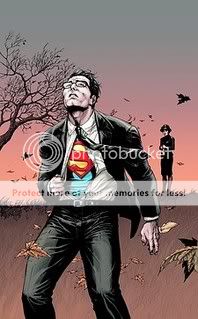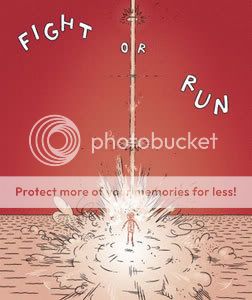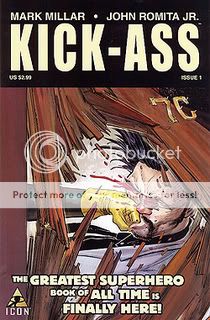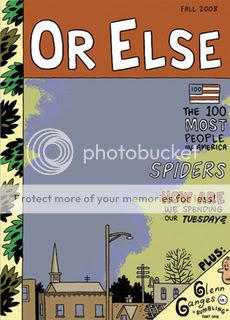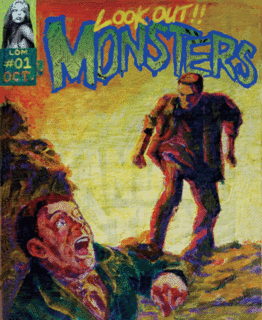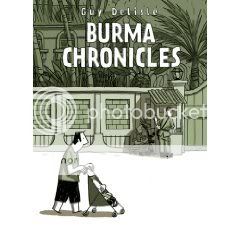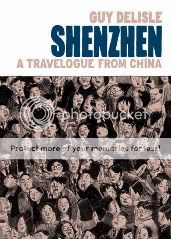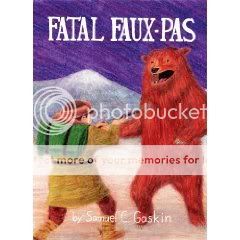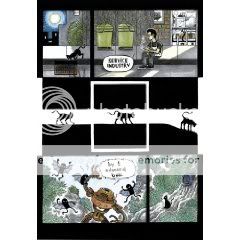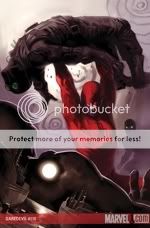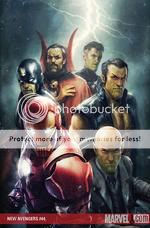Posts Tagged ‘comics reviews’
Comics Time: The Mage’s Tower
October 29, 2008The Mage’s Tower
Lane Milburn, writer/artist
Closed Caption Comics, 2008
28 pages
$10
Horror comedies are often neither all that horrific nor all that comedic—and that’s just at the movies. “Funny” “horror” comics, the kinds of things that fill out the Previews section of many an Image Comics wannabe, are frequently among the most aggressively useless books on the stands. So The Mage’s Tower is sort of like rooting through your junk drawer and finding fifteen grand in crisp hundred-dollar bills. Lane Milburn not only has killer comedic timing, he also has great horrific timing, which is essentially the same thing–knowing just when to deploy a certain image to maximize its impact–but done in the service of the bizarre and disturbing.
This lovely-looking screen-printed minicomic contains three stories rooted in Milburn’s customary Black Sabbathy monsters and demons idiom. “Lugubrious Dunes” centers on the slacker son in a family of grotesques who embarks on a quest to kill some Gamorrean Guard types and get it on with a princess who has the head of a lizard–but it turns out this is all a fantasy, soon interrupted by his haranguing mother, who summons the kid to a “family dance meeting” that’s as ridiculous as it sounds. “Fisticuffs” is a page of just that, starring two creepy brutes with amusingly incongruous, slender swan heads as they duke it out in a fight that ends as rapidly as the one where Kimbo Slice got his ass handed to him in 20 seconds.
The third, final, centerpiece story, the one that really impresses you with the ingenuity of its concept and freshness of its execution, is “The Mage’s Tour.” The play-on-words in the title of the story compared to the title of the comic itself is really the big reveal–we follow two hooded and cloaked beings on what looks like an attempt to storm a villain’s fortress, but that fortress turns out to have been turned into a modern-day tourist trap by said villain, which is what the heroes have come to put a stop to. As the comic plays out, the battle between our heroes and the apostate they’ve come to thwart is intercut with reactions from a tour group who think it’s all part of the act. So as Milburn’s greasy line presents us with increasingly dynamic action and monstrous effects–like Mat Brinkman prints at their most heavy-metal–we keep getting the occasional cutaway to a guy trying to teach his wife how to use the cameraphone to take pictures of the battle and things like that. (“And then I download it?” “Umm…what do you mean?” It’s like a cameo from my mom!) There’s even a laugh-out-loud punchline that gets its own three-color splash page at the end of the book.
This cat’s good. Keep a close eye on him.
Comics Time: Daybreak Episode Three
October 27, 2008Daybreak Episode Three
Brian Ralph, writer/artist
Bodega Distribution, October 2008
52 pages
$10
Buy it from Bodega, eventually
The third and (for the moment) concluding volume of Brian Ralph’s unique, first-person post-apocalyptic zombie comic, Daybreak Episode Three is the series’ most Romero-indebted installment so far. Mad survivors desperately clinging to the literally decomposing remnants of their former life, elegiac post-bite journeys into that good night, “the humans are the real monsters”–this one hits all the classic grace notes, and in specific fashions that bring to mind not just Uncle George’s genre ur-texts but also the series most responsible for reviving its fortunes in comics, Robert Kirkman’s The Walking Dead. What keeps Daybreak from feeling even remotely by-the-numbers even so is Ralph’s joyous, textured cartooning, which lends every actor and environment the same ramshackle, palpable look and feel as his breakthrough caveman adventure Cave-In. You’re simply not going to sit there and sigh “I’ve seen this before,” even if technically you have, in the face of comics this fluid and thoughtfully designed. Just take the character designs as a for-instance: Their cutesy kids’-comics faces and bodies are varyingly employed to make their savage actions all the more disturbing and their sad fates all the more affecting. Placing them in a world as far gone past the point of no return as any this side of The Road is ironically rather fitting, since it suggests a frivolity to their struggles echoed in their just-for-fun appearances. You’ll want things to work out, especially after reading that delightful final page, but you won’t be holding your breath; maintaining that balance between bleakness and simple enjoyment of first-person-shooter shenanigans is quite an achievement.
Comics Time: Cold Heat Special #8
October 24, 2008Cold Heat Special #8
Frank Santoro & Lane Milburn, writers/artists
PictureBox, October 2008
12 pages
I don’t remember how much it cost
Buy it from PictureBox one day
As an object, the eighth* Cold Heat Special is I think the best-looking one yet. The vivid blue/pink/yellow screenprinted cover, with its slightly metal Cold Heat logo and geometric designs, was a real eye-catcher on the SPX show floor, and that’s saying something given the visual cacophony of the place. I enjoyed the story, such as it is, as well–as in previous CH Specials, our teenage leading lady Castle faces a frightening challenge, this time a pretty scary-looking bird-man who attacks her at sea. She manages to beat the beast, scoffing at him in retrospect while brushing her teeth in her underwear within the safety of her bathroom. But then some sort of incubus assaults her, leading to a bout of passion that Castle soon discovers was all in her head–she’s adrift and nearly drowning in the ocean we spotted her on in the beginning, and it takes all she can muster to drag herself to shore, shivering and alone. It’s all in the way you tell it, and if you’ve been following Frank Santoro’s work you know how good he is with layouts, picking just the right moment to show to convey the violence, rapture, and terror of whatever’s going on (it’s a little like All Star Superman in that regard); Milburn, meanwhile, is aces with monsters, imbuing them with a convincing, stocky physicality that also lends itself well to believable sex scenes. The combination of the two artists is memorable, and makes me wonder where the parallel (though disjointed) Cold Heat story being told through the Specials will head next.
* Actually, the 6th and 7th never came out, and The Chunky Gnars is kind of like Cold Heat Special #0.
Comics Time: The Goddess of War, Volume One
October 22, 2008The Goddess of War, Volume One
Lauren R. Weinstein, writer/artist
PictureBox, June 2008
30 pages
$12.95 (they’re pretty big pages, to be fair)
The nice thing about The Goddess of War is that it feels very comic-booky. For one thing, the subject matter is a little purple–it’s about a valkyrie who was so good at her job that she was made the Goddess of War for all humanity, and when she’s not busy heeding the prayers of the violent and deranged and helping mankind reach ever higher and bloodier levels of slaughter, she’s getting drunk off the blood of virgins, mouthing off to her celestial overlords, or having sex with the famed Apache warlord Cochise, whose tragedy-of-errors war with American frontiersmen occupies about half the book. The stereotypical “New Yorker short story” it isn’t.
Then there’s the presentation, hefty 10″ x 15.5″ pages filled to bursting with Weinstein’s muscular character designs and rough-hewn line. Weinstein’s panel borders frequently slash upward or downward across the page, reinforcing the sense that there’s a massive expanse of comics in front of us and she’s filling every inch of it. And there’s something pulpy about the drab greens she’s using for color. Even when she pauses for several 19th-century-style illustrative etchings, the intensity and starkness of their comparatively fine linework just makes you think of an artist marking the hell out of a page. It’s like the whole comic rolls up its sleeves and gets down and dirty. That price point could still be daunting, of course, especially when you note that this is only “Volume One” of an I don’t know how long series, but I for one didn’t feel gypped–you’ve got fantasy, science fiction, erotica, history, war, humor, and drunk-hipster comics all in one big throbbing package.
Comics Time: Action Comics #870
October 20, 2008Action Comics #870
Geoff Johns, writer
Gary Frank, artist
DC Comics, October 2008
32 pages
$2.99
This issue got a lot of attention for (to paraphrase the advertising cliché) killing Pa Kent again, for the first time. I suppose that’s notable, but the Kents were one part of the Superman mythos I never really saw as integral to the whole once they took li’l Kal-El out of the rocketship. (For me the much bigger change to the Superman gestalt came earlier in the arc, when Brainiac revealed that Krypton’s destruction was his doing.) What I took from this issue instead is further appreciation for Geoff Johns’s growth as a writer, and further reinforcement that that growth has been spurred by his close working relationship with Grant Morrison. The multi-page sequence that leads up to Pa Kent’s death is largely silent and rapidly edited, as we follow the separate, desperate actions of Pa, Ma, Superman, Supergirl, Brainiac, Lois Lane, the staff of the Daily Planet, and Brainiac’s missiles, one after the other. It’s the kind of disorienting juxtaposition you find throughout contemporary Morrisonia, if not quite pared down to his level of contextual minimalism (or reliant on his seemingly boundless faith in the intelligence of his audience) then certainly more daring and less ham-fisted than what you’d see in a comparable scene by the vast majority of other popular superhero writers today. The effect both ratchets up the thrill level and heightens the emotional impact–we know we’re seeing something important, but we’re also seeing something exciting. In the context of a superhero comic, it’s basically how death should be done: not by playing to the rafters or the gutters, but by trying to make it pop as brightly as anything else in a superhero comic, if to different effect. In this sense Gary Frank is just the artist for this gig–a kindred spirit to Frank Quitely, replacing Quitely’s Euroisms with a bug-eyed, held-in ferocity that suggests American superhero artists gone slightly psychotic. If you enjoy Superman, this is a run I recommend.
Comics Time: Fight or Run: Shadow of the Chopper
October 17, 2008Fight or Run: Shadow of the Chopper
Kevin Huizenga, writer/artist
Buenaventura Press, October 2008
32 pages
$3.95
Buy it from Buenaventura, I’ll bet
Anyone who read Kevin Huizenga’s hilariously accurate description of the plot of a made-up video game in Ganges #2 knew he’d have a heckuva video game comic in him somewhere, and Fight or Run is that comic. The structure, which we’ve seen him take stabs at a few times in the past, is simple: Two little dudes from a selection of about two-dozen entertainingly designed and named characters–a flying Illuminati eye-in-pyramid named Pronouncement, a little Pac-Man ghost/blob hybrid named Bernini, a guy with a hand for a head named Hander, etc.–face off, one of the critters decides whether to Fight or Run, and it’s game time! The appeal of this comic lies in how Huizenga recognizes that the comfortingly familiar and repetitive parametric structure of video games and works based on them–beat this guy, acquire that object, solve a puzzle, beat a level, repeat–enables visual and logical flights of fancy that would make a blockbuster all-ages starter game like (say) Super Mario Bros. look like a work of ostentatious avant-gardism in any other narrative medium. So here, Huizenga again gets to indulge his inner Powr Mastrs superfan with those character names and designs, while devising increasingly baroque and entertaining ways for the characters to battle, to the point where it’s (duh) much less about the fighting and much more about the fun things you can do with lines on paper, paring certain elements back as far as they can go: a Duck vs. Rabbit fight in which the two characters are distinguishable only by where the handful of lines that connote their beak and/or ears fall on their round, one-eyed heads; a logic diagram that shows the Fight or Run concept, for all its internal variations, has only six possible outcomes. Of course, you can then also ring humor out of unexpected variations on these very simple constituent parts, like Huizenga does with McSkulls, a female fighter who beats her opponents by doing girly things like beating them with her purse, hitting them with a rainbow, riding away on a unicorn or a dolphin, or going out with them and then dumping them (the only time a <3 is used in lieu of an F or an R to connote the choice made by the combatants). There's also something being said here about the folly of ambition in the person of Chopper, the character who participates in the greatest number of F/R contests. He tends to lose because of trying to hard to win in showy ways, like self-dividing until he collapses or skating away on replicas of his own head that are easily transmogrified into giant eyeballs by his ocularly-themed opponent. In the final strip, Chopper runs from the sinister Kid Torcher (aka Kid President, aka Kidder/Torturer (so dubbed in front of an American flag background, no less (I think you get the drift))) and ends up winning his fight only by living his entire life and then dying of what must in the Fight or Run world be natural causes. I'd read an entire collection of comics this deceptively simple and sharp if I could.
Comics Time: Kick-Ass #1-4
October 15, 2008Kick-Ass #1-4
Mark Millar, writer
John Romita Jr., artist
Marvel/Icon, 2008
32 pages each
$2.99 each
The first four issues of Mark Millar’s John Romita Jr.-drawn creator-owned series leave me with two dominant impressions: 1) JRJR’s work is so pretty! 2) I don’t think I’ve ever read a comic so terrified of homosexuals. It honestly could be entered into a court case as proof positive of the “gay panic” defense. Good guys, bad guys, and neutral characters alike drop homophobic epithets like they were going out of style (which they are!), and the main character spends about twice as much page time tearing himself up for allowing the girl he likes to believe he’s gay than he does recovering from watching people get horribly slaughtered in front of him. So far no actual homosexuals have been sexually assaulted or murdered, which in a Mark Millar comic is saying something, but the uptick in “black characters used as cannon fodder” is significant even in Millar’s racially dubious oeuvre, so it’s sort of a wash.
The story is actually a comparatively subdued variation on Millar’s standard routine of adding ultraviolence and a few nods at “realism” to the superhero genre (cf. Ultimates, Wanted, The Authority, War Heroes). This time out, a middle-school (I think) loser, baffled that no one in the world has ever thrown on a mask and costume and gone out to fight crime, up and does so. The gimmick is that when he does so, he gets his ass kicked in spectacularly bloody fashion, over and over, even when he comes out the victor. That’s kind of a funny idea, and Millar (relatively speaking) undersells it, eschewing his usual trick of having the characters tell the reader exactly how awesome they are and dialing the braggadocio down to believably adolescent-male levels.
What it’s mainly good for is allowing Romita to cut lose with all his quirks: wrinkly clothes and finely delineated hair, fights that are a ballet of blocky bodies twisting through the air and torrents of blood gushing like one of those fancy fountains that can spell out words and make pictures of dolphins in whatnot that they have in Asian commerce centers, cute little details (a t-shirt reading “WHATEVER IT IS, AMAGANSETT”–a pop-culture gag whose idiosyncracy stands out in a comic written by a guy who’s still doing Paris Hilton references). Dean White, the sensational colorist find of the past couple years, gives JRJR’s art a milky warmth unique enough to actually say something about the spectacular art it’s supporting. By the time the ten-year-old little-girl ninja shows up and starts slicing up gangstas while calling them “cunts” you realize what a waste of Romita’s capital-A Art it all is, but only homos would complain, and you’re not a homo, right?
Comics Time: Or Else #5
October 13, 2008Or Else #5
Kevin Huizenga, writer/artist
Drawn & Quarterly, October 2008
40 pages
$4.95
Buy it from D&Q if they get it in stock
Or Else #5 is one of Kevin Huizenga’s least showy comics in recent memory, as well as one of his most openly autobiographical; all of that is true despite it mostly being about living in a war-ravaged post-apocalyptic dystopia. The centerpiece story, “Rumbling,” is based on a prose work by writer Giorgio Manganelli, and sees Huizengan everyman Glenn Ganges inserted into a Handmaid’s Tale-esque scenario of warring religious factions as an ambassador from a country “where wars of religion are not waged.” (Amusingly, Ganges later reveals that his homeland fights scientifically rigorous wars of atheism instead. Bill Maher Is Watching You!) I think you can see a little bit of C.F.’s Powr Mastrs (Huizenga’s a fan) sneaking in here, with the strips emphasis on the lavishly constructed uniforms of the various factions’ soldiery and its relatively straightforward pacing and use of genre. The autobio elements slip in through a pair of strips about animal intrusions into the Huizenga/Ganges household–first a turtle in a strip that (I think) openly stars Huizenga rather than his stand-in, then a longer strip about various spiders and wasps that have infested and done battle in Ganges’s house, where the long, lighter-colored hair Ganges is sporting makes him look more like the cartoonist himself than ever. The back-cover photograph of one of the bug battles depicted in the comic adds another real-world/fiction crossover element. The package is rounded out by several strips that focus on picayune details–sentence diagramming, “How Are We Spending Our Tuesday?”, the structure of a conversation between two people represented solely in gibberish, and so on–to such a degree that their meaning is all but lost, like a word repeated into incomprehensibility. Need I mention the effortless cartooning–a loosening line used to connote flashbacks, the military precision with which Huizenga uses grays? It’s not the knockout blow that some previous Or Else issues have been, but as an exercise in Huizenga’s trademark juxtaposition of the quotidian with the universal (and frequently the philosophically troubling), it’s solid; as a unit, though, I’m not sure why it begins and ends where it does and contains what it does.
Comics Time: Travel
October 10, 2008Travel
Yuichi Yokoyama, writer/artist
PictureBox, October 2008
202 pages
$19.95
I love traveling by train, which is good because I’ve done a lot of it over the years: commuting to work from Long Island to Manhattan, traveling up to college in New Haven or down to visit my then-girlfriend in Delaware. Perhaps it’s just these positive associations that feed my affinity for the rails, but thinking about it, I get something out of the journey beyond the destination. A train is an interstitial space, where you can sit for hours in one spot but you’re not actually anyplace, where you move but stand still, where you see parts of the landscape normally as hidden as what you see when you turn your head around on a Disney World attraction to watch the animatronics reset and redeploy for others. Trains are magical.
So is Travel, PictureBox’s second release from Yuichi Yokoyama. I actually like this one better than New Engineering, much better, even. Not because New Engineering wasn’t quite good, because it was–maybe just because what I saw in New Engineering was alien, while Travel, for all its hyperstylization and hilariously deadpan spectacle, is something I can point to and say, “I know this.”
The idea of the book couldn’t be simpler: Three guys get on a train, ride it for a while, then get off. And yes, you read that page count correctly–you’re basically looking at around 180 pages of guys riding on a train. But as with Kevin Huizenga’s Fight or Run, that pared-down parameter gives Yokoyama free reign to indulge in some of the most dynamically staged and inventively drawn comics you’re gonna see all year. The 45 pages or so (!) the guys spend walking through the train to find a seat actually had me laughing out loud after a while, as each fellow passenger they pass looks more and more hysterically taciturn despite their outlandishly detailed clothing and hairstyles, and each attempt to squeeze through a crowded aisle or purchase something in the concession car is depicted from an angle that makes it look like something out of the Wachowski Bros.’ Speed Racer. (That’s a compliment.) When they finally do take their seats, we’re then treated to a tour de force recreation of nearly every possible thing you can see through your window on a train–cities and fields, sun glare and rivulets of rain, parallel trains and passing traffic, our reflection in the window and our reflection in the windows of buildings outside–or inside the train car itself–other passengers walking by, clouds of smoke from cigarettes, another traveler pulling a book out of his jacket to read in a manner so dramatically presented you expect him to whip out a gun and start shooting Colin Ferguson-style.
That something so plotless can remain so gripping for so long is a testament to Yokoyama’s ability to pick unexpected ways to show us everyday things, from the subtle effects of perspective and distortion he can ring out of his simple line to astute use of repetition and slight variation to convey passage through space and time. It’s early yet, but I wouldn’t be surprised to see this near the top of my eventual Best Comics of the Year list. I certainly look forward to rereading it on the train.
Comics Time: Look Out!! Monsters #1
October 8, 2008Look Out!! Monsters #1
Geoff Grogan, writer/artist
self-published, September 2008
32 pages
$9.95
Where did this thing come from? I was handed a copy of Look Out!! Monsters by creator Geoff Grogan’s wife at SPX, and they seemed like friendly, unassuming folks–certainly not the hipstery enfants terribles you might expect to be behind a comic like this. Meanwhile, Google tells me that Geoff Grogan is a cartoonist behind a Rat Pack pastiche called Nice Work, a Xeric Grant recipient for this very comic, and a writer-about-comics who penned this interesting essay challenging the artcomics approach of Kramers Ergot. As it turns out, his work in Look Out!! Monsters would fit nicely next to the Kramers volumes on your bookshelf. Like the best stuff in that anthology series, its art–painted over collaged pieces of The New York Times–calls attention to its own construction but is nevertheless harnessed to an emotionally rich narrative. It’s really impressive.
The nuts and bolts of the book feature Frankenstein’s monster appearing in the smoking crater left behind by an airstrike during what looks like World War I. The Monster assaults a trench full of soldiers in a thrillingly staged fight that evokes both Jack Kirby and David Mazzuchelli, before a cleverly constructed transition suddenly finds both us and the Monster whisked away to a Gothic cathedral. There things take a turn for the creepy, with the Monster mimicking a gargoyle’s disgorgement of water, before the comic gets all non-narrative on us, with huge splash pages and spreads of Frankensteinian lab equipment, Lee/Kirby unstable-molecule pseudo-scientific dot-printed epiphanies, images of unspecified violence and romance, the return of the Monster to assault a hapless victim, and finally the collapse of the Twin Towers. Beneath it all–literally, since the canvas consists of newspaper snippets–are hints of the chaos unleashed by that catastrophic attack, as terrifying and unpredictable as the creation of Frankenstein and the Fantastic Four, rough beasts slouching toward Bethlehem to be born. It’s beautiful to look at and very hard to shake; concept and execution are both very successful on a variety of levels. Do look out for it.
Comics Time: Abe Sapien: The Drowning
October 6, 2008Abe Sapien: The Drowning
Mike Mignola, writer
Jason Shawn Alexander, artist
Dark Horse, 2008
144 pages
$17.95
Maybe the most interesting thing about Mike Mignola’s Hellboy/B.P.R.D. franchise is how at this point in its history, when Mignola and his collaborators are producing enough miniseries set in this world to give the impression that it’s actually one big ongoing monthly (if not two!), the material is actually at its bleakest. What was once a rollicking Jack Kirby vs. H.P. Lovecraft mash-up—albeit one that wedded the former artist’s bombast and visual joie de vivre with the at times oppressive horror of the latter—is now almost a tone poem about three-time loserdom. Pretty much every Hellboy-related miniseries over the past extremely productive year or so has left me feeling really sad about the characters, who regularly confront evidence that they’re just not up to snuff, and that there are things in the world so horrible that even a demon, a fishman, a ghost, a firestarter, a resurrected black-ops officer, and a small army of experts and soldiers look like pikers compared to it.
That’s certainly the theme of Abe Sapien: The Drowning, the first solo series dedicated to Hellboy’s gilled second banana. Set during one of Hellboy’s earlier hiatuses from the Bureau of Paranormal Research and Defense, it shares with the current series of Mignola/John Arcudi/Guy Davis minis a sense that without the Big Red One around, without his guiding force, his colleagues and friends can barely keep their head above water. Some people are different and special because of it, the message seems to be, but some people are just different, and that makes life a long, difficult struggle indeed.
In this case, Abe is sent on what’s supposed to be an easy mission in order to break him in as a solo operative: Swim around off the coast of a former leper colony to retrieve a magic dagger once used to kill a warlock, now resting on the ocean floor somewhere. It doesn’t go so well. One thing that struck me is just how much Mignola uses certain tropes that obviously scare him on some level in nearly all of his books: little unassuming guys transforming into big giant horrible monsters; groups of creepy servant people; mouths opening and extruding something huge and terrible. Nearly all of this is reflected in the plot, which starts out small and seemingly clear and soon balloons into a morass of shifting and expanding alliances and motives. Poor Abe is out of his depth in more ways than one.
Besides being one of Mignola’s more emotionally affecting stories of late, it’s also one of his most effective as horror. That’s largely down to the art of Jason Shawn Alexander, who owes less to Mignola’s high-contrast cartooning or Guy Davis’s neurotic line and more to the ’80s and ’90s horror and dark fantasy of artists like the Hampton Brothers, Pratt, and John Van Fleet (all of whom are amusingly name-checked as B.P.R.D. agents). There are a great many striking panels (the burning ghost priest, the statue of Saint Sebastian, the moray eel) and a few genuinely frightening, tough-to-look-at ones (the old woman in the window, the face of the warlock, the converted church). I know there’s a knee-jerk reaction to a writer-artist farming out part of his workload to other creators, but Mignola’s choices in that regard, from Arcudi and Davis to Richard Corben to Alexander) have been consistently terrific. The same is true of their comics.
Comics Time: Burma Chronicles
October 3, 2008Burma Chronicles
Guy Delisle, writer/artist
Drawn & Quarterly, 2008
272 pages, hardcover
$19.95
Early on, I thought that this was going to be my least favorite of Delisle’s three tyranny travelogues. This time out, instead of Delisle being sent to China or North Korea due to his job as an animator, it’s his wife, a member of Doctors Without Borders, whose career has brought Delisle to Burma (technically Myanmar, but that’s essentially the “slave name” assigned it by the ruling military junta, so many countries don’t use it). This means that the daily grind of work that formed the spine of Delisle’s activities in Pyongyang and Shenzhen gets replaced with laps around a pool, cute business with his baby Louis, and a generally more tourist/holiday vibe. The more it starts to feel like a James Kochalka sketchbook diary the more you feel the absence of that structure. (The inclusion, for the first time, of slapsticky wordless vignettes doesn’t help either.)
But in a way, this is fitting, because Burma as a nation seems to be missing the usual structure as well. As seen through the glimpses Delisle is afforded, China is a country that’s genuinely interested in the economic products of the modern professional, though not the cultural and political ones, and is milking them for all they’re worth. North Korea is too far gone to make a go of that, but to flatter itself and properly impress its subjects, the regime makes a show of being modern; it can’t afford not to lie about it. Now, perhaps it’s just Delisle’s lack of gainful employment that masks bustling business elsewhere in the city of Rangoon, but Burma as a government seems perfectly content with letting the people with whom Westerners come in contact live in relative, non-Westernized simplicity, while away from Western eyes–in entire zones of the country where foreigners are not permitted–the real economic and military depredations take place. Indeed, shielding their doings from outsiders appears to be their number-one concern.
This picture begins to emerge about a quarter of the way through the book and slowly picks up steam because, for the first time, one of Delisle’s travel memoirs has a sort of real-life “plot”: The death by a thousand cuts to which the junta is subjecting Western charities and NGOs, preventing them from reaching the people who need them the most (persecuted minorities) and slowly forcing them to shut themselves down lest they end up complicit in the government’s discrimination. Slowly the junta’s efforts at reality control become harder to miss–culminating most absurdly in the wholesale relocation of the capital from Rangoon to a prefab city in the middle of nowhere whose name can’t even be released to the public for security reasons.
Once again Delisle is a jolly, slightly frantic fish out of water, but this time the juxtaposition between him and his host nation is more poignant than ever. Two stories stick out: A meditation retreat at a Buddhist monastery, the simplicity of which seems to almost haunt Delisle after the information overload of all his other journeys throughout the country; and a heartbreaking incident in which Delisle beamingly presents a French newspaper article about his sojourn in Burma to the amateur animators he’s been teaching as a hobby, only to discover that because of its critical tone toward the junta, one of his students is soon “disappeared.” In both of these very different cases Delisle is left wondering how life could be lived that way, and so are we.
Comics Time: Shenzhen
October 1, 2008Shenzhen
Guy Delisle, writer/artist
Drawn & Quarterly, 2006
152 pages
$19.95, hardcover
Shenzhen is the second book to be released in French-Canadian cartoonist/animator Guy Delisle’s series of travelogues about working in Asian dictatorships (although I believe it was the first to be written); the art in both the ones I’ve read so far is so effortless and well-constructed it almost disappears. This book’s predecessor, Pyongyang, was a really breathtaking look at life in the country with the worst human rights record on Earth–I mean, how can you top a fish-out-of-water story set in a nation that seems to have used 1984 as a how-to manual? You can’t, really, and Shenzhen doesn’t come across as an attempt. Since the Chinese autocracy, at least in the areas Delisle visits, is far less all-pervasive than Kim Jong-Il’s, the book is by necessity a lot less about normal workaday life butting up against the contours of a nightmarish totalitarianism. Obviously there’s a culture clash to be found, but Delisle is quite aware that whatever “inscrutability” he finds in the customs and habits of his hosts lies at least as much with him as it does with them.
Instead, Shenzhen slowly reveals itself to be about how life in the city–an economic “free zone” surrounded by electric fences and guard towers, a place that’s freer than nearly any other in China yet still drearily proscripted–is sort of a macro version of what Delisle’s internal life as a working stiff is in micro. While in many ways Delisle and his European and American counterparts have much more freedom than anyone he’ll meet in China–at a “miniature world tour” tourist attraction he reflects that if he wanted he could simply buy a ticket to India and visit the actual Taj Mahal, while a tiny, rat-infested replica is as close as any of his co-workers are ever likely to get–his dispiriting daily routine is hardly any different from those of his Chinese counterparts. The biggest discrepancy appears to lie in the availability of leisure products: There’s something quite poignant about how his co-workers glom on to whatever meager scraps of Western art and entertainment they can get–a single picture of a Rembrandt painting, a Magic Johnson highlight reel, a painting of a French dinner setting, bootleg movies with the theater audience visible and audible–while Delisle can lie on his bed and listen to “the new Portishead CD” and wonder what the maid in his hotel, who occasionally uses/abuses his discman while she cleans, must think of it. What emerges is a picture of life in a state that has gone from Communist to corporatist, accruing the world-power benefits of wealth while passing few of its normally attendant social improvements down to the workers who make that wealth possible–and the disquieting hint that we Western wage slaves, whatever somatic advantages we might have, are a lot more similar to the workers of Shenzhen than we’d like to believe.
Comics Time: Fatal Faux-Pas
September 29, 2008Fatal Faux-Pas
Samuel C. Gaskin, writer/artist
Secret Acres, 2008
96 pages
$10
I’ve got some friends who aren’t artists per se but love comics and are pretty sharp thinkers about how they work, and when they draw, this collection is what they draw like. In that way this is a fun read, as experiencing the enthusiasm of someone who’s doing comics not because of a killer set of innate chops but for love of the game is a fun thing to do. Well, at least it is in this case, because unlike the usual soul-destroying genre efforts and aimless self-indulgent autobio/humor things produced with the same impetus, this book is actually drawing from a pretty strong set of influences and is being harnessed by a guy who learned enough tricks about pacing from big-time altcomix people to use some of them himself.
That said, it really is just a collection of small, weirdish doodles and (mostly) half-funny-haha half-funny-strange strips. It’s not going to light the world on fire, though to be fair, obviously it’s not meant to. There’s a thing about cavemen that looks a little like Tom Gauld, a Saved by the Bell parody that looks a little like Esther Pearl Watson, there are a couple of little-weird-dude strips who look a little like Marc Bell, there’s a collage-image-type thing that looks a little like Paper Rad, there’s a John Porcellino homage that looks a lot like, you guessed it, Hal Foster. (Haha, no, John P.) There are a some longer, not-quite-funny things involving Harry Potter summoning Black Sabbath and a Hollywood hack director trying to ape Werner Herzog by deliberately acting like a crazy person on set. If all this stuff were by one of my friends I’d be like “Hell yeah, awesome!”, and even as it stands it makes me want to my hand at doodling some stuff, but that’s really not the greatest idea, is it. Still, it’s nice to be made to feel that way once in a while, don’t you think?
Comics Time: Service Industry
September 26, 2008Service Industry
T. Edward Bak, writer/artist
Bodega Distribution, 2007
30 pages
$9.95 (don’t worry, they’re big pages)
In my experience most autobiographical comics come from a place of, if not quite acceptance, than at least understanding. To be really pat about it, they seem to be an artist’s way of making sense of their own lives. Not so with T. Edward Bak’s Service Industry, which feels less like a reflection upon events and more like a wounded, panicked wail about them. The book’s structure–alternating with little warning between present-day ruminations, autobio flashbacks, and dreamlike flights of fancy shot through with atheistic metaphysics and brutal self-deprecation–suggests nothing so much as a man coming apart at the seams. The Bak presented here has been driven to the brink by being a thinking man who’s realized he can’t think himself out of the problems that demand his mental and emotional attention. He’s aware of the pointlessness of his menial job as a dishwasher in the increasingly stratified American class system, which in its way he blames for a tormented family history that includes his mother’s abandonment of his infant sister, his military father’s abandonment of the whole family (to become a minister), and his own abandonment of his ethnic heritage–but he feels incapable of doing anything about any of it. Certainly he rejects the potential of his comics to make a bit of difference, and in that light his draftsmanship and line–neither as sophisticated as his concepts or layouts, but both adequate–actually reinforce his point through their lack of showiness. (It’s easier to bellyfeel that Bak feels like it’s all a waste of time than it would be if he could draw like Chris Ware.) It’s this conflict between awareness and agency that fuels Service Industry‘s ever-increasing sense of desperation, and possibly even breakdown. In that way it’s a frightening comic. You know how you reach a certain age and notice you’re not getting any happier, and instead of being romantic in a teenage-wasteland kind of way, the idea that you’ll be battling sadness for the rest of your life now fills you with abject horror?
Comics Time: New Engineering
September 24, 2008New Engineering
Yuichi Yokoyama, writer/artist
PictureBox, 2007
232 pages
$19.95
Copies of New Engineering should be automatically sent to any comics artist who draws action for a living, through the mail, courtesy of state or local authorities, in much the same way that Billy Joel’s Greatest Hits is issued to all Long Island residents when they reach age 10. It’s just something they’re going to need if they want to keep up.
Unfettered by plot or character considerations as such, Yokoyama’s comics are pure action: combat and construction most memorably, but also travel and some sort of bizarre approximation of automation. With a no-nonsense line Yokoyama follows objects in motion, allowing layout within each panel and on each page to be dictated simply by the inherent length of each action beat rather than any kind of human or emotional component. The result is an always fresh, frequently thrilling approach to choreographing and staging the movement of physical bodies through space.
In battle comics like “Book” and “Model Room,” Yokoyama frequently captures his combatants and their weaponry at the vertex of their movement–that moment at the top of the roller coaster where you’re about to shift from tilting forward to tilting backward. The view constantly shifts to show us the most exciting possible vantage point, allowing thrown objects (or people!) to guide us to a new vantage point within the space. (Think of that bit in The Fellowship of the Ring where we travel across the chasm with Legolas’s arrow and switch our POV when it hits its target, so we now are seeing all the physical space described by the arrow’s path.)
Yokoyama’s “Engineering” comics, wild onslaughts of strange, seemingly purposeless terraforming of featureless natural landscapes into pre-fab mountains, rivers, forests and so on, do just as much to call our attention to how things move. I particularly like the contrast between the great rolls of astroturf that unfurl off into the distance and the enormous boulders that are dropped from above and thud into their destinations as resolutely as possible. The human workers in these comics are also dynamos, frantically running around performing their tasks and screaming all the way. (You’ll have to check the footnotes for the sound effects to pick up on that, though. Yokoyama’s art is inseparable from his sound effects, leaving his translators with the unenviable task of figuring out how to tell us what the hell is going on. They opt for a footnote approach so as not to clutter up the art, which I understand, but as always with manga I think a discrete English subtitle beneath each sound cue would go a long way toward legibility.)
I think it’s that fast pace, and the screaming, that give us the key to what’s going on here. (Or maybe not–the interview and notes included in the supplemental material don’t reveal a lot regarding his philosophical intentions, which to be honest is fine with me.) Everything in New Engineering happenshappenshappens and then ENDS, often in the most nonsensical ways–the cataclysmic “Engineering” series in particular tends to end with amusing anticlimaxes, like everyone rushing into the big boulder-thing they just built only to stand still in a small square room. It’s a rush to do big out of control things for little discernible purpose, and certainly no regard for their ultimate effects. It all feels eerily familiar.
Comics Time: Captain Britian & MI:13 #5
September 22, 2008Captain Britain and MI:13 #5
Paul Cornell, writer
Pat Oliffe, artist
Marvel, September 2008
32 pages
$2.99
Hahahahahahaha! What a last page! I can’t remember the last time I was that tickled and delighted by the end of a superhero series’ monthly installment. Heck, the last time I laughed that hard at a comic, I was reading Tales Designed to Thrizzle. But this is a different kind of laugh, the kind you get from watching Doomsday or something like that–ah, I don’t want to spoil it. You should read it for yourself.
Which I suppose is what I want to say about the whole comic. Captain Britain & MI:13 has had an unusual life so far. It’s part of Marvel’s recent strategy of launching new ongoing series with story arcs that tie in with the event du jour. In this case, Captain Britain, the Black Knight, Spitfire, Pete Wisdom, John the Skrull and some other British heroes repelled a Skrull invasion of the U.K. designed to capture the magic of Avalon to use against humankind. It was a clever enough raison d’etre for a tie-in, reminiscent of the way The Incredible Hercules had a Secret Invasion tie-in arc about gods from Marvel’s various pantheons waging war against the Skrull’s own deities, but since this was the first glimpse anyone had at the series it was tough to figure out how it would feel when removed from that event-comic “everybody against overwhelming evil for all the marbles” feel. I figured I’d take a look at this issue, the first one outside the SI umbrella, think to myself “eh, well done for what it is, but not for me,” and be on my way.
Chances are I’ll be sticking around. Writer Paul Cornell is taking a pre-existing, already appealing batch of characters and concepts and putting them together in a solid team concept: a melange of gaudy, famous superheroes, secret Captain America-style black ops guys, and enthusiastic civilian-adventurers are employed to keep the United Kingdom safe from evil supernatural entities freed during the Skrull invasion. Now that I think of it, it’s a bit like the full-of-promise Breakout arc of New Avengers, where a varied group of superheroes formed an ad hoc team dedicated to tracking down supercriminals freed during a raid on a supermax prison, and finding whoever was responsible for the breakout. That very quickly got sidetracked by storyarcs explaining who each of the more obscure team members actually were, but it was a swell idea, and hopefully here we’ll see it put into practice.
But more than just the nuts and bolts basics of the superconcepts involved (which I’ll admit are a big part of it–heck, a part of me thought that even if it was a bad book I’d stick around just to see if and when Union Jack joined the team), Cornell has imbued it with lively, entertaining dialogue, particularly from the sensational character find of the comic, Faisa Hussain. This accidental superheroine–a motormouthed, starstruck, Excalibur-wielding, (oh yeah) Muslim doctor who gained healing powers from a Skrull contraption–is just a cool code name away from being the most unique, and well-realized, new Marvel hero since the Runaways. (Although I guess none of the Runaways’ codenames ever really stuck. Oh well.) It’s the kind of writing capable of making the arrival of Blade (British-born, you know) actually seem like a big honking deal. Which leads us to that last page…hahahahahahahahaha!
Earlier in the ’00s, many of the best superhero comics self-consciously dealt with self-conscious second-string superheroes and supervillains. While the marquee characters were still tied up with fairly old-school superheroics, writers from Brian Michael Bendis to Peter Milligan examined what it might be like to be an extraordinary being who, for whatever reason, wasn’t seen as being all that extraordinary by the people of their world. It was an extremely meta idea–after all, it was real-world fans who decided that Spider-Man was a superstar, and the fiction just twisted to reflect that. Eventually it became a reflexive tic of writers to have any characters who weren’t members of the Justice League, the Avengers, or the Uncanny X-Men describe themselves as D-listers, and whatever point was being made about celebrity or identity was lost. These days, the most rewarding superhero titles that star characters who aren’t on the short list for movie treatment–The Incredible Hercules, The Immortal Iron Fist, Agents of Atlas, Captain Britain–don’t comment on that fact, they take advantage of it, using these characters’ remove from the Big Events and megateams to carve out their own way of doing superhero comics: incorporating other genres, expanding their mythologies, giving the characters a different goal, adopting a different tone than the current “Lost riff and/or summer popcorn movie” options have to offer. As seen here, it’s an engaging, successful strategy.
Comics Time: Daredevil #110
September 19, 2008Daredevil #110
Ed Brubaker & Greg Rucka, writers
Michael Lark & Stefano Gaudiano, artists
Marvel, September 2008
32 pages
$2.99
Since I last took a Comics Time look at this series, it’s remained the least attention-getting of Ed Brubaker’s Marvel titles, lacking the sales of Uncanny X-Men and Captain America and the buzz of Immortal Iron Fist and Criminal. In that time it’s become a Gotham Central reunion, too, with Greg Rucka joining the Brubaker/Lark/Gaudiano team. And it’s taken a big step away from constantly crescendoing turmoil for the life of its main character, which has been the series’ M.O. since Brian Michael Bendis and Alex Maleev took it over, if not since Frank Miller established the template. What you’ve got instead feels more like a Law & Order: Special Victims Unit, as Daredevil and his private investigator friend Dakota North pull a Stabler & Benson and try to figure out why the FBI is covering up the murder of children while framing a former super-thug. Turns out it’s a Lucky Luciano-style deal with one of Marvel’s stock gangland figures to keep an eye on the docks he runs, ensuring that no Latverian or Madripoorian terrorists sneak in.
In other words it’s nothing you haven’t seen before…yet there’s something enormously satisfying about that. As much fun as it can be to follow superheroes through a series of interconnected, constantly escalating crises, it can also be pretty exhausting. Stepping back from shadowy masterminds manipulating Matt Murdock’s life for pleasure and profit and simply having the guy break the fingers of crooked Feds to spring a character named Big Ben from jail has its own rewards. Meanwhile, if we must get macro about it, finally letting DD settle in to a status quo, however briefly, can only enhance the impact of his next world-turned-upside-down arc. God only knows who or what “Lady Bullseye” is and what or who she’ll be doing next issue, but I’m happy to have a potboiler breather before finding out.
Comics Time: Pocket Full of Rain and Other Stories
September 17, 2008Pocket Full of Rain and Other Stories
Jason, writer/artist
Fantagraphics, 2008
160 pages
$19.99
Surely one of the great miracles of living in this, the New Golden Age of Comics, is that one can own in the neighborhood of a dozen different Jason books, in English. Perhaps the single strongest page in this entire collection is the final one, where the covers of nine of the great Scandinavian cartoonist’s other available works are arranged in a Watchmen-style grid. It makes you want to declare victory on behalf of comics and go home. Mission accomplished!
In the early days of Jason’s translation and introduction into the English-speaking altcomix world, I remember hearing complaints about how Fantagraphics was presenting only one side of a very multifaceted artist–the grim, silent side. Perhaps that was true at the time, but in setting up such an austere (and, lest we forget, extraordinarily impressive) foundation, Fanta only served to heighten the impact of each new release as it strayed into the unexplored territory of genre–comedy, horror, thrillers, science fiction, and more, each with Jason’s trademark ruminative, fatalistic edge.
Pocket Full of Rain represents the apotheosis of this trend, dipping into the artist’s rich back catalog to dredge up works that expand the boundaries of what constitutes a “Jason comic” not only narratively but artistically. Showcasing a variety of early art styles–realism, funnypages cartooniness, altcomix weirdness–outside of his usual anthropomorphism, it’s dazzling in how conclusive an argument it makes that Jason could have gone in any of those directions and been nearly as successful as he is today. The title story, an existential thriller in the mode of Why Are You Doing This? only with humans (and the occasional alien) in lieu of funny animals, sort of makes me wish I could dip into an alternate universe where Jason’s career doing Gilbert Hernandez-style magic-realist crime stories using Adrian Tomine-like figurework continues unabated. (The way he plays with the passage of time, metonymizing scenes into single panels, is particularly reminiscent of Los Bros’ skills in that area.) A handful of surreal stories about death toward the end of the collection reveal an artist who’s equally at home actually doing horror as he is riffing on it in books like The Living and the Dead. A sampling of gag strips involving a prisoner, a cactus, a ghost and other seemingly randomly selected images plucked from Jason’s subconscious might have blossomed into a hit webcomic in a different era. Yet despite dating back as long as 15 years ago, it’s all of a piece with Jason’s familiar and haunting obsession with the capricious nature of life, as represented by sudden violence, the non sequitur intrusion of pop culture icons and tropes, the random collection of moments that taken together constitute love or its loss. Either as an introduction to Jason’s work or a reward for those who’ve followed it all along, this book’s a gem.
Comics Time: New Avengers #44
September 15, 2008New Avengers #44
Brian Michael Bendis, writer
Billy Tan, artist
Marvel, August 2008
32 pages
$2.99
I’ve been following Marvel’s Secret Invasion event somewhat with the half-hearted interest of someone who mainly wants to know what went wrong. The primary miniseries going under that title has seen six issues come and go, during which time virtually nothing has actually happened that can’t be described with the sentence “The Skrulls invade, but not hard enough.” Nick Fury and His Howling Characters No One Cares About have been battling the Skrulls’ Mighty Marvel Mash-Ups in New York City for what seems like three years, Avengers both New and Mighty gathered in the Savage Land for an inconsequential fight with an entire shipful of head-fake superhero impostors, Reed Richards got captured but now he’s free with his de-Skrulling gun that he made on the way back from Outer Space, Thor broke free from J. Michael Straczynski, and Bucky dropped in from a better comic. There you have it! It’s sort of the apotheosis of problematic Brian Bendis event comics, with lots of people and lots of people standing around and sounding kind of the same and kind of out of character, a lot of things happening but none of it really mattering, and in general all of it being far less successful than his more focused, solo-character-based superhero work, which treats the superhero idiom like the world’s strangest psychological coping mechanism and/or mental breakdown.
The real Secret Invasion action, in terms of enjoyable comics, has mostly come in the primary tie-ins, New Avengers and Mighty Avengers. This particular issue shows Bendis doing what he does best–“going there.” I’ll tell anyone who’ll listen that when big-deal villains show up, they should always majorly fuck up the lives of the heroes they fight, every time. It should be a rule. Granted, the Skrulls we see at work here are doing what they’re doing to lab-grown clones of Reed Richards so as to probe his mind for secrets they need for their Invasion to be successful–it’s not Richards himself–but man oh man, do they ever show how far they’re willing to go in service of their plans. Instead of standing around and talking like the world’s most violent Scientologists, or dressing up like random assemblages of other Marvel characters and shooting Human Torch fire or Cyclops lasers outside the borders of their double-page spread, they’re systematically creating human life only to torture and destroy it. Now that’s the kind of villainy I can get behind! Take it together with the other issues in these ongoing series, which tend to focus on “what’s up with So-and-So and how did the Skrulls get to him/not get to him” questions with precision, perverse imagination, and unsparing ugliness, and you have to wonder if some of this material couldn’t have been present in the main mini. If you’d shoved aside all the explosions and summary executions, you could have made room for the serious-business character crises that made Bendis the superhero writer to read in the early part of this decade, and still make Powers and Ultimate Spider-Man among my favorite genre titles.



